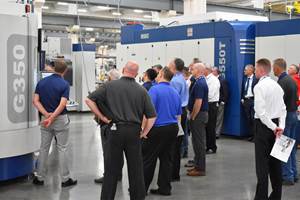New Wire EDM System Enhances Mold Maker's Capabilities
When Osley and Whitney, Inc. (Westfield, Massachusetts) decided to upgrade its wire EDM (electrical discharge machining) capabilities, the company had several problems it wanted to solve. Osley and Whitney, a 48-year-old plastic injection moldbuilding company with 68 employees, serves automotive, automotive aftermarket, consumer, sporting goods and office machine companies.
Share





When Osley & Whitney, Inc. (Westfield, Massachusetts) decided to upgrade its wire EDM (electrical discharge machining) capabilities, the company had several problems it wanted to solve. Osley & Whitney, a 48-year-old plastic injection moldbuilding company with 68 employees, serves automotive, automotive aftermarket, consumer, sporting goods and office machine companies.
The machine the company wanted to replace left a lot to be desired. "The workpiece deterioration with our old machine was driving us crazy," says Roger Beauregard, the company's vice-president of manufacturing. "We weren't able to cut a normal cavity seat in F7 or H13_especially over the weekend_not only because we didn't have an automatic wire threader, but also because when we came back to work the next morning or on Monday, we'd find the workpiece had turned into a pile of rust.
"We tried making molds out of 420 stainless steel. We tried coating the exterior surfaces with rust-inhibiting paint. We even tried putting grease on the workpieces. Unfortunately, the only solution that ever really worked was to have a production person on-hand at the end of every run to take the workpieces out and wipe them down immediately. That was a big handicap, of course, because when we wanted to have a long burn overnight or over a weekend, we couldn't do it."
The company decided to purchase a wire machine, the Robofil 330F from GFAGIECHilles Technologies (Lincolnshire, Illinois), to add to its five ram machines.
The new Robofil 330F's submerged operations and filtration system coupled with a dielectric of deionized water and an automatic wire threader solved the rusting problem. Osley & Whitney now cuts all kinds of steel, along with aluminum, graphite and copper, at all times of the day and night. "The filters last longer than we thought they would, and although we knew very little about filtration before we bought this machine, it's been a great help to us already," Mr. Beauregard says.
The machine has had other positive effects too, such as an improved cutting speed, much faster than the one it replaced. Roger Poirier, vice president of sales and engineering at Osley & Whitney, adds, "We verified the speed improvement and cost savings by running a distributor cap replacement job as a test. This design features two mating parts and a parting line that actually forms the outside shape of the part. Basically, this is a cone-shaped part that's larger on the bottom than at the top. It is loaded with fillet radii and scallops that ultimately produce a smooth exterior surface.
"When we ran the job in our old wire machine, it required 16 hours per cavity. When we ran the same job again on the new wire machine, it took four hours per cavity. What's more, with the GFAGIECHilles, we're able to generate the radii and put in the fillets, notches and scallops at the same time."
John Monaghan, company president, adds, "Now that we've upgraded, we've come to rely on wire EDM running up to 80 hours a week to generate all of the electrodes for our ram work. Of course, we also use wire to cut inserts for through-pockets and for other typical applications."
Making it easier to do taper-cutting in tall workpieces was another thing Osley & Whitney desired. "We found the new machine could cut 30-degree tapers up to 15.75 inches (400 mm)," says Mr. Poirier. "With most of the other machines we evaluated, they could cut 30-degree angles but not to the full range of the machine."
The new wire machine's Fanuc control unit has also been a plus. "We're very familiar with Fanuc controls," says Mr. Poirier, "And the control includes pre-set values allowing us to select optimal cutting speeds and feeds based on the materials and thicknesses we're running. The control asks a few on-screen questions, you press a button, and you're off and running."
The GFAGIECHilles Robofil 330F features X-Y-Z travels of 15.75 inches (400 mm) by 11.8 inches (300 mm) by 15.75 inches (400 mm), plus U-V travels of 19.68 inches (500 mm) by 15.75 inches (400 mm).
Related Content
Punch Custom Tooling Supports Range of Manufacturing Processes
Punch Industry designs custom tooling for injection molding, stamping and equipment manufacturing processes.
Read MoreIn Moldmaking, Mantle Process Addresses Lead Time and Talent Pool
A new process delivered through what looks like a standard machining center promises to streamline machining of injection mold cores and cavities and even answer the declining availability of toolmakers.
Read MorePunch Industry USA Pins, Punches Yield Precision Surface Finishes
PMTS 2025: Punch Industry USA exhibits its “polish-less” custom round and specialized shaped punches, button dies and mold pins.
Read MoreGrob Systems Inc. to Host Tech Event With Industry Partners
The 5-Axis Live technology event will highlight new machining strategies for optimizing the production of complex medical, aerospace and mold/die parts.
Read MoreRead Next
How I Made It: Dennis Rymanowski
Dennis Rymanowski has worked at NSH USA for 60 years, with his passion for manufacturing living alongside his passion for his family’s polka band.
Read MoreA New Frontier in Surface Finish Control
What if your machine tool could measure surface roughness as it cuts? This article explores how in-process metrology is advancing from concept to reality, enabling real-time feedback, immediate detection of anomalies and new levels of control over surface quality. Discover the technologies making this possible.
Read More






















